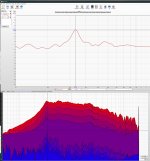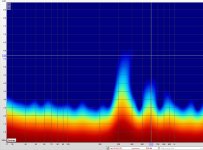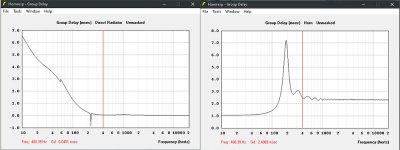And the TD-2001 with the J-321 JMLC horn.
It loads but also beams like h....
Been lurking here a while and would like to thank everyone involved, I’m learning a lot from you guys!
However I’m thinking; looking at these pretty pictures of wg:s and horns performing in isolation is one thing but irl they have to be playing along with another driver.
F.i. placing the acoustical center of the hf driver wayyy behind the mid/lf driver like in the picture of the JMLC horn will have huge consequences for the filter, introduce loads of group delay and wreak havoc on those pretty lines.
Camplo, I'm sorry, but this is all false. I see people parroting this stuff so often that I became apathetic enough not to oppose it, but it simply makes no sense (again...). I just felt it needs to be said now, and again, I'm sorry for that.[...] We can see the knee at 300hz....this horn is only good till about 600hz...its basic horn theory, you know this already I would think...to play properly to 300hz, you'd need a 150hz horn....at horn fb there is a peak in Group delay that is no good for SQ as well as a peak in spectral decay, also no good for SQ....Fb on this horn is at or near 300hz.
You are going ot have to give an example for me to get what mean by that example...and please do. Love more perspectives
A 15 degree beam.... which is about what these larger horns have at the top....22inch windows at 7 ft....I judge window size by -3db instead of the -6db standard btw =)
This is a 1 man seat, but an easy seat, for one man
If you go by a -6db it gets bigger yet. For the studio guy, its not much of a sacrifice for ultimate SQ in return....
A 15 degree beam.... which is about what these larger horns have at the top....22inch windows at 7 ft....I judge window size by -3db instead of the -6db standard btw =)
This is a 1 man seat, but an easy seat, for one man
If you go by a -6db it gets bigger yet. For the studio guy, its not much of a sacrifice for ultimate SQ in return....
Camplo, I'm sorry, but this is all false. I see people parroting this stuff so often that I became apathetic enough not to oppose it, but it simply makes no sense (again...). I just felt it needs to be said now, and again, I'm sorry for that.
Im open minded, educate me! Measurements speak volumes. Theres a peak in group delay and decay in my 350hz horns at basically 350hz so, so far me 1 you 0...
Theres also modulation in the electrical impedance showing the harmonic modes I spoke of as well...
I've shared all my measurements once before let me know if I need to again....
Actually I'll attach some graphs, hopefully to help square this out.
The 3ms group delay at 350hz can't be good for SQ....I mean we want to see under 2ms by 100hz....Burst decay is new to me but peaks are not the goal
Attachments
Last edited:
I don't know where to start. For one thing, the group delay and the frequency response of the horn alone are in fact the same thing (as long as it's a minimum phase device, which no one has ever shown otherwise). After you think about that for some time, think about the frequency response behind a crossover, and the summed frequency response of the whole system. You will realize that 1) any horn equalized to the same frequency response will end up having exactly the same group delay, and 2) that it's the crossover that determines the group delay of the system as a whole - there you can make by far the biggest difference, even eliminate it to a large degree.
The raw group delay of the device alone is virtually irrelevant, as is its freqency response, as long as it's smooth and clean and the output is high enough for the intended application.
The raw group delay of the device alone is virtually irrelevant, as is its freqency response, as long as it's smooth and clean and the output is high enough for the intended application.
Last edited:
Yeah I've got work to do I guess....cause thats the farthest thing from the truth that I know....but hey, ya learn something new every day.....the group delay and the frequency response are in fact the same thing.
If you have any visual proof of this...that usually helps me.
When I spl match my sim of the 15" woofer vs axi on 150hz horn the group delay is not the same at the spl matched frequency so yeah I am loooossst
According to your words at 400hz where I matched spl GD should be the same...
Attachments
Last edited:
Just use a linkwitz transform on it, and you can give every horn SYSTEM the same response.
But exactly like woofers, depending on the Fs and Qt of the driver (as well as the Vas I guess, even for high drivers), this might cost a lot of extra power as well as additional cone excursion.
It's important to understand that there are two separate things going on. The "loading " or rather the piston part of an high driver (high driver is either compression driver or a tweeter). This follows basically the same rules as any other linear phase system.
The other part is the beaming part. Which is pure acoustics, and doesn't have anything to do with control theory systems anymore.
Unfortunately physics always have to comply to the law of misery. So both are being affected at the same time, so there is always a compromise.
They sort of meet half in between (not really true but figure of speech)
As any other system, max output vs best phase vs best freq resp vs whatever other parameters you have.
The whole loading "theory", formulas and explanation is only about optimizing the lower piston part of an horn system.
In that sense I really agree with Geddes to call optimized horns for the beaming (acoustic) part, waveguides.
But exactly like woofers, depending on the Fs and Qt of the driver (as well as the Vas I guess, even for high drivers), this might cost a lot of extra power as well as additional cone excursion.
It's important to understand that there are two separate things going on. The "loading " or rather the piston part of an high driver (high driver is either compression driver or a tweeter). This follows basically the same rules as any other linear phase system.
The other part is the beaming part. Which is pure acoustics, and doesn't have anything to do with control theory systems anymore.
Unfortunately physics always have to comply to the law of misery. So both are being affected at the same time, so there is always a compromise.
They sort of meet half in between (not really true but figure of speech)
As any other system, max output vs best phase vs best freq resp vs whatever other parameters you have.
The whole loading "theory", formulas and explanation is only about optimizing the lower piston part of an horn system.
In that sense I really agree with Geddes to call optimized horns for the beaming (acoustic) part, waveguides.
Last edited:
Tutorials
Thank you for your tutorials. Copied both posts and saved in a doc.
And...
The OS waveguide does not have a sharp cutoff like the exponential or hyperbolic horns...
Thank you for your tutorials. Copied both posts and saved in a doc.
Here is one measurement
We can see the knee at 300hz....this horn is only good till about 600hz...its basic horn theory, you know this already I would think...to play properly to 300hz, you'd need a 150hz horn....at horn fb there is a peak in Group delay that is no good for SQ as well as a peak in spectral decay, also no good for SQ....Fb on this horn is at or near 300hz.
Funny!!! You do know i made those measurements, right? And that they had a 300Hz LR 96dB/oct linear-phase high-pass in place?
It better have a knee at 300Hz !
The measurement post . https://www.diyaudio.com/forums/multi-way/368378-me464-horn-2.html#post6549756
Btw, the knee is without any peaking in group delay.
ES-600 horn
I like that horn. It's one I keep in mind for future reference.
The same driver mounted to Joseph's ES-600 Biradial horn.
I like that horn. It's one I keep in mind for future reference.
So what's the point?
I want to see more useful information and less bickering. The bickering is the real 'cut off'.
You guys who are designing this stuff are going to kill it for everyone; including yourselves.
I continue to enjoy the information you share. Glad to see you apart of the discussion.
Excursion vs desired Output, is Daddy. Needed Excursion to reach desired output is going to be the direct link to the quality of the output....as well as where and what type XO can be used, as GM recently made obvious to me.
Appreciate the nice words!
As with tweeters and compression drivers, there is a similar thing to say about using the driver around the Fs.
There seem to be some unstable behavior with higher excursions.
Which can't be seen in the steady state response very well.
But with impedance measurements, one can see a shift in frequency.
This problem is an awful lot less when ferrofluid is being used in the gap (which makes a lot of sense).
So I guess we are going back to that rule of thumb of around 2 x Fs.
On the other hand, when a steeper highpass filter is being used, this is not much of an issue anymore. So 2 x Fs is maybe a little overkill.
That's rather obvious, but exactly like a system with a woofer, it is extremely important to make a clear separation what is what.Of course, the driver itself plays an important role. The horn + driver together form an acoustic system.
Instead of seeing everything all at once the whole time.
Just make a clear overview of all the sub systems, what they do and what their contribution is.
Otherwise there is a risk of making it one big blur of vagueness.
Even more so when people talk about different things at the same time.
One of the reasons I haven't been really joining in to be very honest.
Funny!!! You do know i made those measurements, right? And that they had a 300Hz LR 96dB/oct linear-phase high-pass in place?
It better have a knee at 300Hz !
The measurement post . https://www.diyaudio.com/forums/multi-way/368378-me464-horn-2.html#post6549756
Btw, the knee is without any peaking in group delay.
Lol, I got them from another forum, but I'm sure you recognize your stuff lol
I saw the measurement you shared in your thread here and it looks pretty much the same....identical even lol
It would be great if you would just share your group delay measurements...and burst decay...and electrical impedance if you have that....heck just share rew file while your at it!
I don't know where to start. For one thing, the group delay and the frequency response of the horn alone are in fact the same thing (as long as it's a minimum phase device, which no one has ever shown otherwise). After you think about that for some time, think about the frequency response behind a crossover, and the summed frequency response of the whole system. You will realize that 1) any horn equalized to the same frequency response will end up having exactly the same group delay, and 2) that it's the crossover that determines the group delay of the system as a whole - there you can make by far the biggest difference, even eliminate it to a large degree.
The raw group delay of the device alone is virtually irrelevant, as is its freqency response, as long as it's smooth and clean and the output is high enough for the intended application.
Ok I think I figured it out...you are speaking on how group delay and phase are as you say, the same as frequency response, because of its relationship, being a minimum phase system or something along those lines?
Maybe I have something to teach you then...group delay follows the same trace as time to peak energy....instead of just simply being a derivative of the phase, it is exactly what I describe and just like phase...there is only one "correct". If you will take a REW measurement of horn into rew...open up the spectrogram tab at highest resolution you will see that the trend of time to peak energy is almost an identical copy of the group delay....theres no reason why a higher frequency should take a longer to reach peak energy than a lower frequency but the GD hump at the tuning note does just that as you go below it. This is a result of pressure at tuning lagging the diaphragms motion...highest pressure is at the tuning note. In the several years on this forum, I am the first and only person here ,to my knowledge, to make connection of group delay, to time to peak energy. So I guess this is new for you too.
Group Delay of 3ms at 350hz isnt good for SQ nor is group delay best in the area in front of tuning...
Decay is obviously peaking in the area of fb...
Excursion is modulating in the area before it...
All good reasons why crossing over 1.5-2x fb makes perfect sense
Nothing we've said suggest otherwise....yet
Last edited:
- Home
- Loudspeakers
- Multi-Way
- Is it possible to cover the whole spectrum, high SPL, low distortion with a 2-way?


